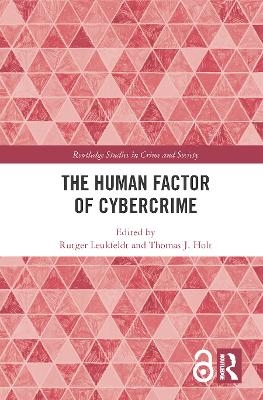
The Human Factor of Cybercrime
Routledge (Verlag)
978-1-138-62469-6 (ISBN)
Cybercrimes are often viewed as technical offenses that require technical solutions, such as antivirus programs or automated intrusion detection tools. However, these crimes are committed by individuals or networks of people which prey upon human victims and are detected and prosecuted by criminal justice personnel. As a result, human decision-making plays a substantial role in the course of an offence, the justice response, and policymakers' attempts to legislate against these crimes. This book focuses on the human factor in cybercrime: its offenders, victims, and parties involved in tackling cybercrime.
The distinct nature of cybercrime has consequences for the entire spectrum of crime and raises myriad questions about the nature of offending and victimization. For example, are cybercriminals the same as traditional offenders, or are there new offender types with distinct characteristics and motives? What foreground and situational characteristics influence the decision-making process of offenders? Which personal and situational characteristics provide an increased or decreased risk of cybercrime victimization? This book brings together leading criminologists from around the world to consider these questions and examine all facets of victimization, offending, offender networks, and policy responses.
Chapter 13 of this book is freely available as a downloadable Open Access PDF at http://www.taylorfrancis.com under a Creative Commons Attribution-Non Commercial-No Derivatives (CC-BY-NC-ND) 4.0 license.
Dr. Rutger Leukfeldt is senior researcher and cybercrime cluster coordinator at the Netherlands Institute for the Study of Crime and Law Enforcement (NSCR). Furthermore, Rutger is director of the Cybersecurity & SMEs Research Center of the Hague University of Applied Sciences. Over the last decade, Rutger worked on a number of cybercrime studies for the Dutch government and private companies. Rutger is currently the chair of the Cybercrime Working Group of the European Society of Criminology (ESC). Dr. Thomas J. Holt is a professor in the School of Criminal Justice at Michigan State University specializing in cybercrime, cyberterrorism, and the police response to these threats. His work has been published in a range of journals, and he is also the author of multiple books and edited works.
Part I: Background; 1. It ain’t what it is, its the way that they do it? Why we still don’t understand cybercrime Mike McGuire; 2. Contributions of Criminological Theory to the Understanding of Cybercrime Offending and Victimization Adam Bossler; 3. The Open And Dark Web: Facilitating Cybercrime And Technology-Enabled Offenses Claudia Flamand and David Décary-Hétu; Part II: Victims; 4. Predictors of Cybercrime Victimization: Causal Effects or Biased Associations? Steve van de Weijer; 5. Virtual Danger: An Overview of Interpersonal Cybercrimes Jordana Navarro; 6. Sexual Violence in Digital Society: Understanding the Human and Technosocial Factors Anastasia Powell, Asher Flynn and Nicola Henry; Part III: Offenders; 7. Cybercrime subcultures: Contextualizing offenders and the nature of the offence Thomas J. Holt; 8. On Social Engineering Kevin Steinmetz, Richard Goe, and Alexandra Pimentel; 9. Contrasting cyber-dependent and traditional offenders: a comparison on criminological explanations and potential prevention methods Marleen Weulen Kranenbarg; 10. Financial cybercrimes and situational crime prevention Rutger Leukfeldt and Jurjen Jansen; 11. Modelling Cybercrime Development: The case of Vietnam Jonathan Lusthaus; 12. Humanizing the Cybercriminal: Markets, Forums, and the Carding Subculture Craig Webber and Michael Yip; 13. The Roles of ‘Old’ and ‘New’ Media Tools and Technologies in the Facilitation of Violent Extremism and Terrorism Ryan Scrivens and Maura Conway; 14. Child Sex Abuse Images and Exploitation Materials Roderic Broadhurst; Part IV : Policing; 15. Policing Cybercrime: Responding to the Growing Problem and Considering Future Solutions Cassandra Dodge and George Burruss; 16. Responding to individual fraud: Perspectives of the Fraud Justice Network Cassandra Cross; 17. The Ecology of Cybercrime Benoît Dupont; 18. Displacing big data: How criminals cheat the system Alice Hutchings, Sergio Pastrana and Richard Clayton
| Erscheinungsdatum | 31.10.2019 |
|---|---|
| Reihe/Serie | Routledge Studies in Crime and Society |
| Zusatzinfo | 18 Tables, black and white; 4 Line drawings, black and white |
| Verlagsort | London |
| Sprache | englisch |
| Maße | 156 x 234 mm |
| Gewicht | 771 g |
| Themenwelt | Informatik ► Netzwerke ► Sicherheit / Firewall |
| Recht / Steuern ► Strafrecht ► Kriminologie | |
| ISBN-10 | 1-138-62469-1 / 1138624691 |
| ISBN-13 | 978-1-138-62469-6 / 9781138624696 |
| Zustand | Neuware |
| Haben Sie eine Frage zum Produkt? |
aus dem Bereich


